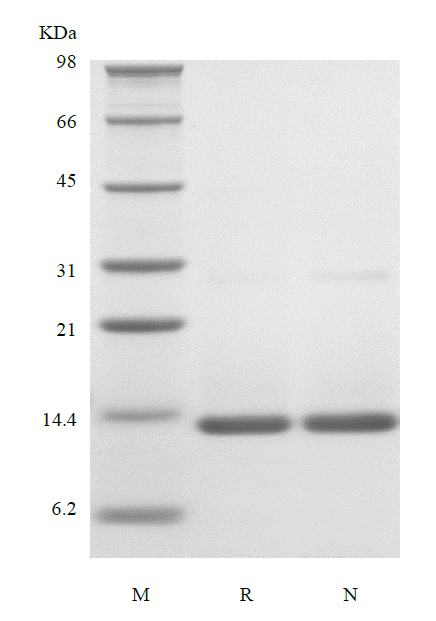- Synonyms
-
- Source
- Escherichia coli.
- Molecular Weight
- Approximately 15.5 kDa, a single non-glycosylated polypeptide chain containing 134 amino acids.
- AA Sequence
- QGTLIESLES LKNYFNSSSM DAMEGKSLLL DIWRNWQKDG NTKILESQII SFYLRLFEVL KDNQAISNNI SVIESHLITN FFSNSKAKKD AFMSIAKFEV NNPQIQHKAV NELIRVIHQL SPESSLRKRK RSRC
- Purity
- > 97 % by SDS-PAGE and HPLC analyses.
- Biological Activity
- Fully biologically active when compared to standard. The ED50 as determined by an anti-viral assay using murine L929 cells infected with encephalomyocarditis (EMC) virus is less than 0.1 ng/ml, corresponding to a specific activity of > 1.0 × 107 IU/mg.
- Physical Appearance
- Sterile Filtered White lyophilized (freeze-dried) powder.
- Formulation
- Lyophilized from a 0.2 µm filtered concentrated solution in 1 × PBS, pH 7.4, 1 mM DTT, 5 % Trehalose and 0.05 % Tween-80.
- Endotoxin
- Less than 0.1 EU/µg of rRtIFN-γ as determined by LAL method.
- Reconstitution
- We recommend that this vial be briefly centrifuged prior to opening to bring the contents to the bottom. Reconstitute in 10 mM HAc to a concentration of 0.1-1.0 mg/mL. Stock solutions should be apportioned into working aliquots and stored at ≤ -20 °C. Further dilutions should be made in appropriate buffered solutions.
- Stability & Storage
- Use a manual defrost freezer and avoid repeated freeze-thaw cycles.
- 12 months from date of receipt, -20 to -70 °C as supplied.
- 1 month, 2 to 8 °C under sterile conditions after reconstitution.
- 3 months, -20 to -70 °C under sterile conditions after reconstitution.
- Usage
- This material is offered by Shanghai PrimeGene Bio-Tech for research, laboratory or further evaluation purposes. NOT FOR HUMAN USE.
- SDS-PAGE

- Reference
- 1. Wang H, Ruan Z, Wang Y, et al. 2008. Mol Immunol, 45: 1548-56.
2. Kopinski P, Przybylski G, Jarzemska A, et al. 2007. Pol Merkur Lekarski, 23: 15-21.
3. Pennino D, Bhavsar PK, Effner R, et al. 2012. J Allergy Clin Immunol,
4. Hibi M, Hachimura S, Ise W, et al. 2003. Cytotechnology, 43: 49-55.
- Background
- Interferon-gamma (IFN-γ), also known as Type II interferon or immune interferon, is a cytokine produced primarily by T-lymphocytes and natural killer cells. The protein shares no significant homology with IFN-β or the various IFN-α family proteins. Mature IFN-γ exists as noncovalently-linked homodimers. It shares high sequence indentity with mouse IFN-γ (86 %). IFN-γ was originally characterized based on its antiviral activities. The protein also exerts antiproliferative, immunoregulatory and proinflammatory activities and is thus important in host defense mechanisms. IFN-γ induces the production of cytokines, upregulates the expression of class I and II MHC antigens, Fc receptor and leukocyte adhesion molecules. It modulates macrophage effector functions, influences isotype switching and potentiates the secretion of immunoglobulins by B cells. Additionally, IFN-γ augments TH1 cell expansion and may be required for TH1 cell differentiation.

 COA申请
COA申请
